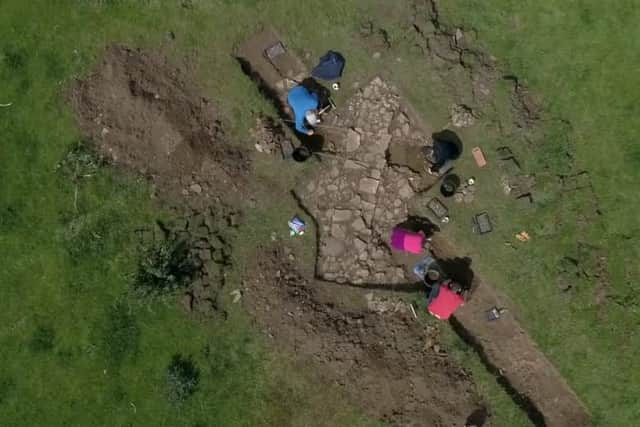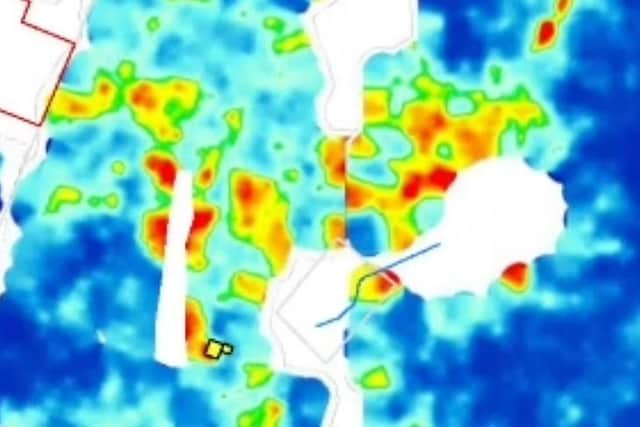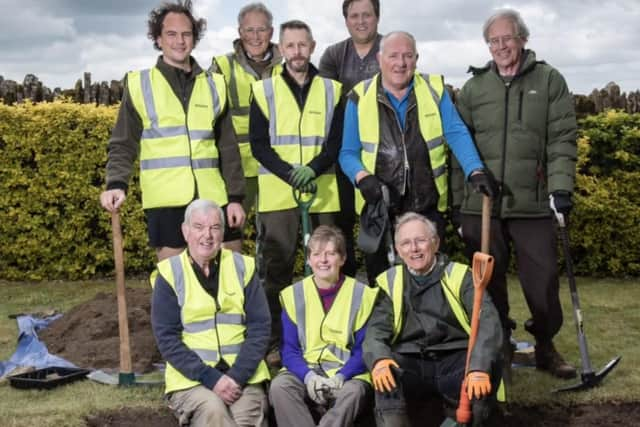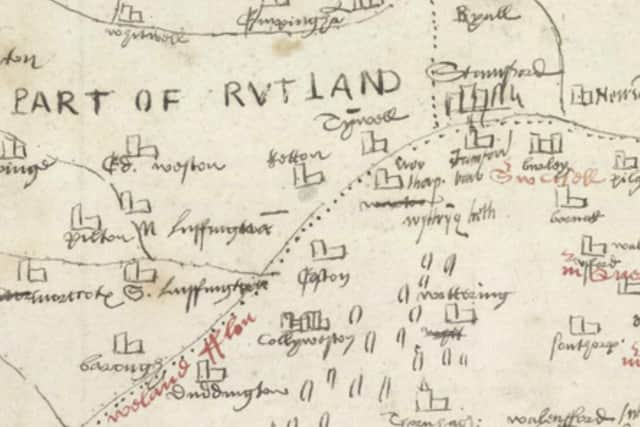Legendary, long-lost palace discovered near Stamford by historical society described as 'bunch of amateurs'
and live on Freeview channel 276
Move over Indiana Jones; a group of amateur historians in our region have made a startling archaeological find near Stamford – the remains of a long-lost Tudor palace.
The Collyweston Historical and Preservation Society (CHAPS) – who modestly describe themselves as “a bunch of amateurs” – made the remarkable discovery within their sleepy village following a dedicated five-year search.
Advertisement
Hide AdAdvertisement
Hide AdExperts have recently confirmed that the site discovered is indeed that of a grand 15th-century palace once used by Henry VIII and Elizabeth I.


Legend and local hearsay
CHAPS had long been obsessed with the prospect of finding the long-lost landmark as, for anyone who grew up in Collyweston, the village’s Tudor palace was something of a legend that had been lost for centuries.
The group’s’ chairman Chris Close explains
“I was brought up in the village, along with many others, and we heard, even as kids, that there was this thing called a palace in Collyweston.”


Keen to prove it was more than just a myth, the good men and women of CHAPS decided to make good use of their “local knowledge and local hearsay” to take on the task of searching for the royal palace in 2018.
Advertisement
Hide AdAdvertisement
Hide AdSadly, the group’s initial efforts yielded nothing other than an abrupt reality check:
“We were all brought up watching programmes like Time Team,” Chris says,”who make this [task of] finding historical buildings look very easy.”
“The reality of amateur archaeology is that you’re constantly battling against things like funding and a lack of expertise.”


“We had no maps, no illustrations, no records saying ‘go to this spot and you’ll find it - just little hints.”
It was, Chris recalls, quite dispiriting:
Advertisement
Hide AdAdvertisement
Hide Ad“Imagine doing a jigsaw puzzle but you haven’t got the box with the picture on, and you’ve got ten thousand pieces, of which you’re only given a few each year.”
And then there was that issue of funding.


The society’s lack of money was put into perspective when an expert archaeologist, Gary Coates, told Chris that CHAPS’ entire budget for the whole project would be equal to the catering budget of just one episode of Time Team.
“Fortunately we had a group of very enthusiastic amateurs in the dig team that came from all around Peterborough; they donated their time for free and we gave them pizzas, teas and coffees.”
“That’s how we got around the funding challenge.”
Additional financial support was also provided by generous local businesses like Rutland Scaffolding, Collyweston Slate Mine, and Messenger BCR, while various community and regional funding opportunities also helped to tide things over.
Advertisement
Hide AdAdvertisement
Hide AdFinally, after years of being super-resourceful and carrying out endless amounts of research, digging and surveys, the group received the best kind of vindication.
Discovery and vindication
In summer 2023, following the use use of ground-penetrating radar (GPR) and Lidar (Light Detection and Ranging), the Collyweston Historical and Preservation Society discovered – finally – an intricate series of below-ground structures “to the west of Collyweston High Street.”
The group’s findings were subsequently confirmed by experts from the University of York in August.
Noted archaeological geophysicist John Gater, a regular on the popular Channel 4 series Time Team, echoed the experts’ conclusions:
Advertisement
Hide AdAdvertisement
Hide Ad“Scrolling through the time slices creates an image of rooms or buildings within a larger structural complex,” he said.
“As such, it is tempting to interpret the results as being associated with a substantial structure and given the historical records, it seems a reasonable supposition to suggest these could be part of the long lost Collyweston Palace.”
The find revealed the palace to be not one large property but rather a complex of buildings - many of which were now within the grounds of present day residents’ gardens.
The Society was, understandably, thrilled when their discovery received official recognition:
Advertisement
Hide AdAdvertisement
Hide Ad“I was immensely proud,” Chris admits: “We devoted a lot of man-hours to this project.”
“It’s been a real team effort.”
Rise and fall
CHAPS’ tireless on-site digging and diligent off-line detective work has already revealed plenty of tantalising details about the legendary palace.
“Modern day technology [like Lidar and GPR] has given us a distinct advantage,” Chris acknowledges, “as it has enabled us to see what is in the ground in terms of linear features, etc.”
In addition, the dig team has unearthed fascinating artefacts from the 15th century, such as ornate stone mouldings and bits of medieval pottery.
Advertisement
Hide AdAdvertisement
Hide AdBy all accounts, the extensive palace – which once maintained a household of several hundred people – would have been a mega-mansion in its prime.
Indeed, the English antiquarian and historian William Camden is reported to have described the Palace of Collyweston as ‘handsome and elegant’ in 1607.
“We didn’t really know how important this palace was – or how big it was – until we got doing this project,” Chris admits.
Collyweston Palace was gifted to Henry VIII's grandmother, Lady Margaret Beaufort after her son, Henry VII, won the Battle of Bosworth (1485).
Advertisement
Hide AdAdvertisement
Hide AdAccording to Historic England, the palace was very well known throughout the 15th and 16th centuries, acting as both an administrative and meeting venue for royal family gatherings.
“Collyweston at that time would have been a village attached to a palace,” Chris notes; “not the other way round.”
Henry VIII is recorded as holding court at the palace on two occasions in 1541.
His daughter, Elizabeth I, the Virgin Queen, hosted several Privy Councils on the site during her reign.
Advertisement
Hide AdAdvertisement
Hide AdIn addition, the landmark building hosted a number of other historic events, including the pre-wedding celebrations of Henry VIII's sister, Margaret Tudor, to James IV of Scotland in 1503.
The palace fell into disrepair over the next century and, in 1650, it was bought by the Dutch Tryon family who eschewed the now decayed palace buildings, preferring instead to build new properties on the site.
However, it is thought that even by the mid-1700s, a tower, dungeon and part of the palace’s great hall were still present.
Sadly, all materials from the old manor were completely removed by 1780 when the Cecil family purchased the manor.
Advertisement
Hide AdAdvertisement
Hide AdEarthworks, garden terraces, and a couple of fishponds were the only hint that a significant building had ever been present.
Present and future
The discovery of the Collyweston Palace has been big news.
The society’s meetings have been “selling out” since the find, with people coming from all over the country to learn more about the incredible find.
Moreover, Chris and his team have been inundated with interview requests from regional newspapers, national broadsheets and international broadcasters.
In order to manage the ever-increasing public interest, the Society has set up a modest exhibition in the local church.
Advertisement
Hide AdAdvertisement
Hide AdThe CHAPS website is also being updated regularly to help ensure all discoveries made are shared with the wider world.
Chris is hopeful that a 3D mock-up of the palace – to be made with help from the University of York – will also become a reality in the coming months.
So what’s next for the team?
“It’s not the end of the project by a long way,” Chris says, enthusiastically: “We’ve still got a lot of things to answer about the palace.”
The exact layout of the palace, with its as-yet undiscovered formal entrance, tops the list of things Chris and his willing army of helpers are most keen to find out next.
Advertisement
Hide AdAdvertisement
Hide AdThere’s also the tantalising prospect of seeing whether anything of the lauded ‘great hall’ remains.
“We’ve got work starting at the end of February to hopefully try and resolve some of these questions,” says Chris.
In all, there are another six further digs planned for the upcoming year, all of which will be carried out by CHAPS.
Taking his eye off the future for one moment, the proud chairman is keen to acknowledge his team’s achievements.
Advertisement
Hide AdAdvertisement
Hide Ad“It’s been a real community effort that the Society should be proud of,” he says.
“It’s definitely been a win, not only for Collyweston but also for Stamford and the South Lincolnshire area.”
All in all, not bad - for a bunch of amateurs.